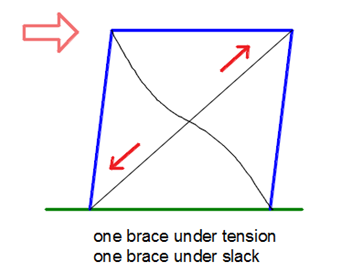Tension-only bracing
MkaPEB can consider inter-frame bracing as a tension-only member. Tension-only bracing is particularly common in low-rise and light-industrial buildings due to its simplicity, efficiency, and cost-effectiveness.
This system utilizes steel in its most efficient structural role — carrying loads in tension — which allows for significant material savings compared to compression-based systems. The bracing members in such designs are typically slender elements, such as steel rods, cables, or flat bars. Because of their minimal cross-sectional area, their compressive strength is negligible, and they are not intended or designed to resist compressive forces.
During service conditions, tension-only braces engage only when lateral forces, such as wind or seismic loads, act on the structure and cause displacement. As a result, they provide lateral stability and control sway by developing tension forces, while buckling under compression is deliberately avoided. This characteristic simplifies the design, reduces member weight, and lowers fabrication and erection costs. Moreover, because the braces only function under tension, they can be detailed with simple end connections, such as pinned or clevis-type fittings, further enhancing constructability.

Created with the Personal Edition of HelpNDoc: Streamline Your CHM Help File Creation with HelpNDoc